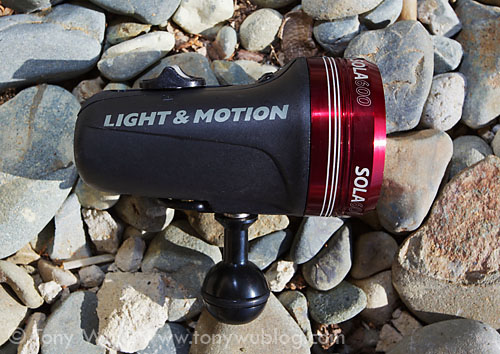This has been the trip to try new stuff.
In addition to the Totomega insect eye lens, I've been using three SOLA 600 lights (made by Light & Motion) for the first time.
I normally don't use focus lights on my camera, primarily because most lights made for underwater use are some combination of large, heavy and awkward. In addition, many have bulky, brick-like chargers, which can be a pain to pack/ carry.
To date, I've relied on natural light during the day and help from a dive guide at night. On occasion I've hand-carried a standard dive torch, shining the light with one hand while working my camera with the other. Not the most ideal set-up, but I've been making do for many years.
All that's changed now with the SOLA lights. Here's why:
First, the lights are small. Really small. Like "fits-in-your-palm, Japanese-miniaturised" small, which means they're easy to transport, no trivial consideration in this age of draconian baggage restrictions. As a bonus, the chargers for the SOLA are also tiny.

Light & Motion's SOLA 600 light
The lights are self-contained, so there's minimal flooding risk, and no worrying about which batteries to buy/ replace before/ during your trip. Just plug the charger into the back of the light and let the power grid do its thing.
Most importantly, the lights are oh-so-simple to use: Push the toggle on the top of the light forward to cycle through medium, high, and low power; push forward (or backward) and hold for two seconds to turn the light off; twist the toggle sideways to lock the power button; And the best part…pull the toggle backward for red light.
The built-in red light means you don't have to wrap red plastic around your light for night dives, and you can easily switch back-and-forth between white and red illumination. How's that for convenience?
In case you couldn't tell, I love these lights.
After diving with them for a couple of weeks, I've found three uses:
1. As a torch. Strap a lanyard onto the SOLA 600, and it's a lightweight, versatile torch.
2. As a focus light. As I mentioned above, I've never used focus lights on my cameras, because underwater lights tend to be bulky and/ or fiddly. SOLA lights are small, light, decidedly non-fiddly.
Also, the red light function is invaluable for night dives. Some of the critters I've come across in Ambon still seem to be able to see the red light, but this built-in stealth mode works in most instances, allowing you to sneak up on unwary photographic quarry.

SOLA 600 light as a focus light
3. As video lights. Two to three SOLA 600s have been enough to light video footage (which I'll post after I get back) I shot during the Ambon Night Safari with my DSLR cameras. I was able to use a decent ISO (160 to 640 range on my Canon cameras), with exact settings depending upon lighting I wanted, subject size, colour and distance. (Note: Light & Motion has just released a new SOLA 1200 light, which provides even more light for video, in the same compact package.)
It was probably no small coincidence that there were lots of SOLA lights on the Ambon Night Safari trip, since all the participants were dedicated, well-informed divers. We also had a couple of prototype SOLA 1200 units that Eric Cheng brought along.
In summary: For travelling photographers, who need to cut down on baggage, standardise equipment, and have maximum redundancy…SOLA lights are a no brainer. In fact, if you have a dive-addicted person in your life, SOLA lights would make a perfect stocking stuffer for the coming holiday season (how's that for a subtle hint?).
No product is perfect, of course, so if you get the lights, I'd recommend going easy on the toggle switch that turns the lights on-and-off. I've had no issues, but one person who was here snapped the toggle off by accident. The light still worked fine, but without the plastic toggle, it can be a bit more cumerbersome to operate.
Also, a few people experienced a red tint to their photos when they used the red light. This can happen if you allow a lot of light into your photo, i.e., open up aperture, slow down shutter and/ or pump up ISO. I haven't had this issue, but it's something to take into consideration when you use the red light function.

Collection of SOLA 600 and SOLA 1200 lights
To wrap up, I'd like to thank Light & Motion and Scubacam for providing me with the use of the SOLA 600 lights. The lights were critical to getting many shots, particularly several of the photos I took with the Totomega lens at night. Sneaking up with the red light made all the difference.
Rest assured that I wouldn't talk-up a product I don't truly love. I've lent the lights to several divers who arrived in Ambon after the Night Safari participants left. Based on their reactions, I think it's pretty safe to say there will be several people purchasing SOLA lights when they get home.
Bottom line...The SOLA 600 lights are a home run.